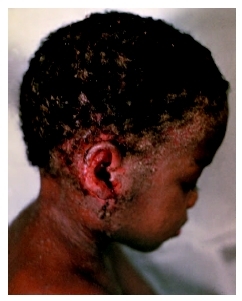Seborrheic dermatitis
Definition
Seborrheic dermatitis is a common inflammatory disease of the scalp and skin characterized by scaly lesions usually on the scalp, hairline, face and body. In infants, it is sometimes called cradle cap.
Description
Seborrheic dermatitis appears as red, inflamed skin covered by greasy or dry scales that may be white, yellowish, or gray. It can affect the scalp, eyebrows, forehead, face, folds around the nose and ears, the chest, armpits, and groin. In infants it appears most commonly on the scalp and is called cradle cap. Dandruff is a mild form of seborrheic dermatitis and appear as fine white scales without red skin or inflammation. Dandruff can also be caused by other skin conditions, especially in children.
Seborrheic dermatitis is a common, mild disease of newborns. The red, scaly rash can spread to the forehead, behind the ears, and in the creases of the neck and armpits. The rash is not itchy and usually does not bother babies. Occasionally babies also develop this skin disease in the diaper area. When seborrheic dermatitis occurs in the diaper area, it is often accompanied by a yeast infection. When yeast is present, the rash is itchy and uncomfortable. Seborrheic dermatitis usually disappears by the end of the first year and does not reappear until puberty .
Transmission
Seborrheic dermatitis is not an infection and is not transmitted from individual to individual.
Demographics
Seborrheic dermatitis is a very common among newborns. It usually appears the first six weeks of life and rarely after the age of nine to 12 months. It affects babies of all races and both genders. Seborrheic dermatitis can reappear at puberty and into adulthood.
Causes and symptoms
As of 2004 the cause of seborrheic dermatitis was not clear. However, it is not an infection or an allergy, it is not contagious, and it is not caused by poor hygiene. Seborrheic refers to the sebaceous, or oil producing, glands of the skin. It appears that in pregnancy, hormone changes in the mother may cause these glands to produce too much oil. When this happens, scales develop in the area where the oil glands are most dense. Seborrheic dermatitis may also be linked to genetic factors.
Babies exhibit a characteristic non-itchy greasy red scaly rash or dry whitish or grayish scales on the scalp and possibly on other areas.

When to call the doctor
If the rash does not improve after regular washings with baby shampoo or if the rash spreads and becomes red and itchy, especially in the diaper area, the doctor should be consulted.
Diagnosis
Diagnosis is made on visual inspection of the rash.
Treatment
Frequent washing of the scalp with a mild baby shampoo followed by brushing with a soft brush to remove scales usually clears up cradle cap. In stubborn cases, a special shampoo containing sulfur and salicylic acid can be used. This treatment should be done only after consultation with a pediatrician, since this shampoo may be irritating to babies. Sometimes an ointment containing cortisone, an anti-inflammatory medication, is prescribed. If the seborrheic dermatitis is complicated by a yeast infection, an ointment containing anti-yeast medications such as nystatin is applied to the infected area three or four times daily.
Alternative treatment
Parents may rub mineral oil into their child's scalp to soften and loosen the scales, but the oil should be brushed or shampooed out and not left to accumulate.
Prognosis
Seborrheic dermatitis normally resolves without difficulty, usually by the age of six months and almost always by the end of the first year. The rash does not leave scars.
Prevention
Seborrheic dermatitis cannot be prevented from developing, although it may be controlled through frequent hair washings with a mild baby shampoo.
Parental concerns
Parents are often concerned that the rash will leave a scar on their baby's skin. However, scarring does not occur.
KEY TERMS
Cortisone —Glucocorticoid produced by the adrenal cortex in response to stress. Cortisone is a steroid with anti-inflammatory and immunosuppressive properties.
Dermatitis —Inflammation of the skin.
Salicylic acid —An agent prescribed to treat a variety of skin disorders, such as acne, dandruff, psoriasis, seborrheic dermatitis, calluses, corns, and warts.
Sebaceous —Related to the glands of the skin that produce an oily substance called sebum.
Resources
WEB SITES
"Cradle Cap." Pediatric Advisor. Available online at http://www.pmhs.org/crs/pa/hhg/cradlcap.htm (accessed November 13, 2004).
"Cradle Cap (infantile seborrhoeic dermatitis)." DermNet NZ. Available online at http://dermnetnz.org/dermatitis/cradle-cap.htlm (assessed November 13, 2004).
Tish Davidson, A.M. Kathleen D. Wright, RN
Comment about this article, ask questions, or add new information about this topic: